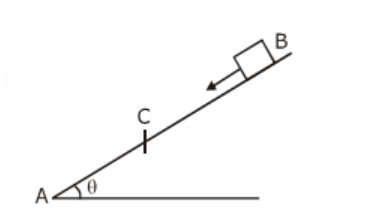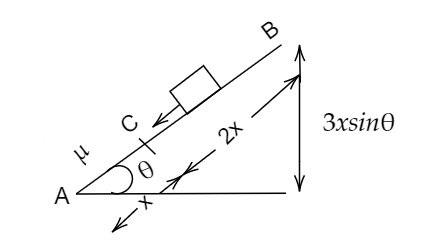
A small block starts slipping down from a point B on an inclined plane AB, which is making an angle θ with the horizontal section BC is smooth and the remaining section CA is rough with a coefficient of friction. It is found that the block comes to rest as it reaches the bottom (point A) of the inclined plane. If\[BC = 2AC\], the coefficient of friction is given by \[\mu = k\tan \theta \]. Find the value of k.

Answer
217.8k+ views
Hint: In order to proceed into the problem, it is important to know about work energy theorem and the frictional force. Work-energy theorem states that the net work done by the forces on an object is equal to the change in kinetic energy of an object. Frictional force is the force acting in the opposite direction of the motion of an object.
Formula Used:
According to the work-energy theorem we have,
Work done =change in kinetic energy
At point B, \[u = 0\] i.e., the initial velocity is zero.
At point A, \[v = 0\] i.e., the final velocity is zero.
Hence change in kinetic energy is zero, then the work energy theorem can be written as,
\[{W_{mg}} + {W_{FF}} + {W_N} = 0\]……………… (1)
Where,
\[{W_{mg}}\] is the work done due to downward force mg.
\[{W_{FF}}\] is the frictional force acting on the block.
\[{W_N}\] is the normal force.
Complete step by step solution:
Now let us solve the problem step by step considering the definition.

Image: Small block slipping down from a point B to A on an inclined plane AB
By the definition of work done we know that,
\[W = \overrightarrow F \times \overrightarrow S \]
Here \[\overrightarrow F \] is the force and \[\overrightarrow S \] is the displacement.
Consider the equation (1)
\[{W_{mg}} + {W_{FF}} + {W_N} = 0\]
\[ \Rightarrow 3mgx\sin \theta + \mu mg\cos \theta \times x \times ( - 1) = 0\]
\[ \Rightarrow 3mgx\sin \theta = \mu mg\cos \theta \times x\]
\[ \Rightarrow \mu = 3\tan \theta \]……….. (2)
By data, \[ \Rightarrow \mu = K\tan \theta \]……… (3)
On comparing the equations (2) and (3) we obtain,
\[K = 3\]
Therefore, the value of K is 3.
Note: Suppose when an object is moving horizontally and then vertically upwards, the force which is required for this motion is more when compared to an object which is moving on an inclined plane upwards. This is the advantage of an inclined plane. When two bodies are in contact with each other the normal force is the force that acts between the objects individually between them. It is a surface force and is normal to the surface of contact of the bodies. If two surfaces are not in contact then, they can't exert a normal force.
Formula Used:
According to the work-energy theorem we have,
Work done =change in kinetic energy
At point B, \[u = 0\] i.e., the initial velocity is zero.
At point A, \[v = 0\] i.e., the final velocity is zero.
Hence change in kinetic energy is zero, then the work energy theorem can be written as,
\[{W_{mg}} + {W_{FF}} + {W_N} = 0\]……………… (1)
Where,
\[{W_{mg}}\] is the work done due to downward force mg.
\[{W_{FF}}\] is the frictional force acting on the block.
\[{W_N}\] is the normal force.
Complete step by step solution:
Now let us solve the problem step by step considering the definition.

Image: Small block slipping down from a point B to A on an inclined plane AB
By the definition of work done we know that,
\[W = \overrightarrow F \times \overrightarrow S \]
Here \[\overrightarrow F \] is the force and \[\overrightarrow S \] is the displacement.
Consider the equation (1)
\[{W_{mg}} + {W_{FF}} + {W_N} = 0\]
\[ \Rightarrow 3mgx\sin \theta + \mu mg\cos \theta \times x \times ( - 1) = 0\]
\[ \Rightarrow 3mgx\sin \theta = \mu mg\cos \theta \times x\]
\[ \Rightarrow \mu = 3\tan \theta \]……….. (2)
By data, \[ \Rightarrow \mu = K\tan \theta \]……… (3)
On comparing the equations (2) and (3) we obtain,
\[K = 3\]
Therefore, the value of K is 3.
Note: Suppose when an object is moving horizontally and then vertically upwards, the force which is required for this motion is more when compared to an object which is moving on an inclined plane upwards. This is the advantage of an inclined plane. When two bodies are in contact with each other the normal force is the force that acts between the objects individually between them. It is a surface force and is normal to the surface of contact of the bodies. If two surfaces are not in contact then, they can't exert a normal force.
Recently Updated Pages
Arithmetic, Geometric & Harmonic Progressions Explained

Cartesian Form of Vector Explained: Formula, Examples & Uses

Apparent Frequency Explained: Formula, Uses & Examples

Calorimetry: Definition, Principles & Calculations

Centrifugal Force Explained: Definition, Formula & Examples

Charge in a Magnetic Field: Definition, Formula & Examples

Trending doubts
JEE Main 2026: Application Form Open, Exam Dates, Syllabus, Eligibility & Question Papers

Derivation of Equation of Trajectory Explained for Students

Hybridisation in Chemistry – Concept, Types & Applications

Understanding the Angle of Deviation in a Prism

Understanding Collisions: Types and Examples for Students

Understanding Atomic Structure for Beginners

Other Pages
JEE Advanced Marks vs Ranks 2025: Understanding Category-wise Qualifying Marks and Previous Year Cut-offs

Units And Measurements Class 11 Physics Chapter 1 CBSE Notes - 2025-26

NCERT Solutions For Class 11 Physics Chapter 8 Mechanical Properties Of Solids

Motion in a Straight Line Class 11 Physics Chapter 2 CBSE Notes - 2025-26

NCERT Solutions for Class 11 Physics Chapter 7 Gravitation 2025-26

How to Convert a Galvanometer into an Ammeter or Voltmeter




